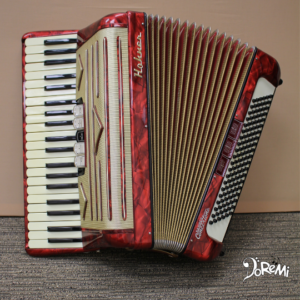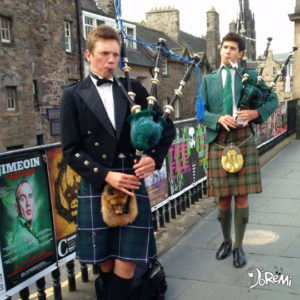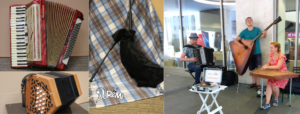Reed Instruments
When we think about reed instruments, we usually consider the most common ones … the sax, the clarinet, the oboe, all of which use cane reeds. But there are some, more unusual, instruments that use metal reeds such as the accordion, the concertina and the harmonica, not to mention the bagpipes and the pipe organ!
As part of a complete music education, we like to introduce our students to a wide variety of both common and unusual instruments and we have all of these, except one, at the school for the students to try.
Accordion
 Although a common instrument in Europe, and especially popular in French culture, the accordion hasn’t always had a warm welcome in North America and many of our students have never seen one before.
Although a common instrument in Europe, and especially popular in French culture, the accordion hasn’t always had a warm welcome in North America and many of our students have never seen one before.
The accordion was invented in the 1820s by the Viennese piano maker Cyril Demian. With its bellows and keys and buttons, it is great fun to play, and one of the few instruments that allows you to perform both melody and harmony at the same time. We use it in class to demonstrate how the students can apply the knowledge they have gained toward understanding how to play additional instruments. The piano accordion is simply a piano on one side, and the Circle of Fifths on the other!

Concertina
 Like the accordion, the concertina is a “free-reed” instrument. Also like the accordion, it has expanding and contracting bellows to move the air across the reeds. The concertina has buttons for both hands, placed on the ends rather than on the front. While there are some accordions that do have buttons for both hands, all of ours are “piano accordions” and have a keyboard for the right hand to play.
Like the accordion, the concertina is a “free-reed” instrument. Also like the accordion, it has expanding and contracting bellows to move the air across the reeds. The concertina has buttons for both hands, placed on the ends rather than on the front. While there are some accordions that do have buttons for both hands, all of ours are “piano accordions” and have a keyboard for the right hand to play.
Unlike the accordion, each button on a concertina makes a different sound depending on whether you are pulling or squeezing the bellows. While making it great fun to play, it also makes it harder than the accordion to understand and learn to play well.
Since the concertina was developed independently in both England and Germany, there are 2 distinct versions of the instrument. The English version was invented in 1829 by Sir Charles Wheatstone, while the German version was introduced five years later, in 1834, by Carl Friedrich Uhlig.
The concertina can be found in classical music, but is more common in the traditional music of Ireland, England, and south Africa. It is also commonly featured in dance music such as the tango and, like the accordion, the polka.
Harmonica
 The harmonica, commonly known as the mouth organ, is also a free-reed instrument. The reed is a flat, elongated spring typically made of brass, stainless steel, or bronze, which is secured at one end over a slot that serves as an airway. When the free end is made to vibrate by the player’s air, it alternately blocks and unblocks the airway to produce sound. The invention of the harmonica is often attributed to Christian Friedrich Ludwig Buschmann, an instrument maker in Berlin, at around the year 1821.
The harmonica, commonly known as the mouth organ, is also a free-reed instrument. The reed is a flat, elongated spring typically made of brass, stainless steel, or bronze, which is secured at one end over a slot that serves as an airway. When the free end is made to vibrate by the player’s air, it alternately blocks and unblocks the airway to produce sound. The invention of the harmonica is often attributed to Christian Friedrich Ludwig Buschmann, an instrument maker in Berlin, at around the year 1821.
The harmonica is used worldwide in many musical genres, especially in blues, American folk music, jazz, country and rock. It is played by blowing into or sucking air out of one or more of the holes along the mouth piece. Behind each hole is a chamber with at least one reed. Like the concertina, the harmonica will make a different sound depending on which way the air is going. Harmonicas come in many types, including diatonic (one scale per instrument), chromatic, tremolo, orchestral, octave, and bass versions.
Although the harmonica isn’t an instrument that we can “share” in class, it is a big hit with our students.
Bagpipes
 The bagpipes have cane reeds in the bottoms of the large drone pipes, and in the chanter pipe that plays the tune. They have a very unique and haunting sound which you will either love or hate. I happen to love them … growing up I had an uncle, a veteran, who played the big bass drum in a marching pipe and drum band, and we went to every parade to hear him! At our very first recital in 2002, our guest performer was a piper. There wasn’t a dry eye in the room when he played my two favourites, Scotland the Brave and Amazing Grace.
The bagpipes have cane reeds in the bottoms of the large drone pipes, and in the chanter pipe that plays the tune. They have a very unique and haunting sound which you will either love or hate. I happen to love them … growing up I had an uncle, a veteran, who played the big bass drum in a marching pipe and drum band, and we went to every parade to hear him! At our very first recital in 2002, our guest performer was a piper. There wasn’t a dry eye in the room when he played my two favourites, Scotland the Brave and Amazing Grace.
 This picture is taken in Edinburgh in 2019, during the Military Tattoo. As Scotland’s national instrument, bagpipes are an integral part of Scottish identity and culture. But, they are not exclusive to Scotland, and there are multiple types of bagpipes from many different countries. The Great Highland Bagpipe, with its large air bag, three drones, tuneful chanter and long mouthpiece is the chosen pipe of Scotland, and the one we recognize the most.
This picture is taken in Edinburgh in 2019, during the Military Tattoo. As Scotland’s national instrument, bagpipes are an integral part of Scottish identity and culture. But, they are not exclusive to Scotland, and there are multiple types of bagpipes from many different countries. The Great Highland Bagpipe, with its large air bag, three drones, tuneful chanter and long mouthpiece is the chosen pipe of Scotland, and the one we recognize the most.
 Neither are the bagpipes native to Scotland. Some of the first known records of the instrument appear around 1000 BC in a Hittite carving from what is now modern-day Turkey. It is thought that the pipes were brought to Scotland by the Romans. The Roman Emperor Nero played the pipes, with the image even being captured on coins. This picture is taken at the Cistercian monastery of Santes Creus in Catalonia Spain, and depicts a medieval bagpiper.
Neither are the bagpipes native to Scotland. Some of the first known records of the instrument appear around 1000 BC in a Hittite carving from what is now modern-day Turkey. It is thought that the pipes were brought to Scotland by the Romans. The Roman Emperor Nero played the pipes, with the image even being captured on coins. This picture is taken at the Cistercian monastery of Santes Creus in Catalonia Spain, and depicts a medieval bagpiper.
Of all the instruments we have here at the school, I find the bagpipes the most difficult to play! The coordination required is overwhelming, and I can’t imagine being able to march properly in a band at the same time. The thing that is unusual with the pipes is how you blow. With all of our other wind instruments, the air you release is used to directly produce the sound. Not so with the pipes. Here you blow simply to keep the bag full, and then the air is released into the instrument by squeezing the bag with your elbow. If you forget to blow because you are concentrating on playing the song (or concentrating on trying to play while you march in formation with your group) then your instrument will stop producing a sound. And I’m told that you are not allowed to simply blow a little on every beat! I thought that I had met my coordination match when I started learning the drums … then I met the bagpipes.
Pipe Organ
 This gigantic instrument is definitely not one you would think of when discussing instruments that have a reed. It is, however, a member of the woodwind family. Some of the pipes you see in the pipe organ are “flue” pipes that produce sound by forcing air through a fipple, like that of a recorder. Others are “reed” pipes, with fixed metal reeds that vibrate inside the tube when air blows through, much like the accordion, concertina and harmonica.
This gigantic instrument is definitely not one you would think of when discussing instruments that have a reed. It is, however, a member of the woodwind family. Some of the pipes you see in the pipe organ are “flue” pipes that produce sound by forcing air through a fipple, like that of a recorder. Others are “reed” pipes, with fixed metal reeds that vibrate inside the tube when air blows through, much like the accordion, concertina and harmonica.
The origins of the pipe organ can be traced back to ancient Greece as early as the 3rd century BC. That instrument was known as a “hydraulis” because the wind supply was created by using the weight of displaced water in an airtight container. Bellows came to be used to supply the air by the 6th and 7th century AD. Over time, more and more pipes were added until the organ evolved into the instrument we know today.
The pipe organ became established in Western Europe in 812 when Charlemagne requested one for his chapel in Aachen. In England, the first organ of which any detailed record exists was built in Winchester Cathedral in the 10th century. It was a huge machine with 400 pipes that required 2 men to play it, 70 men to blow it, and it could be heard throughout the city.
By the 17th century, most of the sounds available on a modern organ had been developed. The pipe organ had become the most complex man-made device ever created, and remained so until it was displaced by the telephone exchange in the 19th century.
Pipe organs are really just a collection of one-note duct flutes. They come in all shapes and sizes. Some were even created to be portable, with the flutes stored in a box. Composers such as Bach often referred to the organ as a “box of whistles”. The pipe organ was one of Bach’s favourite instruments, and his compositions form an important part of the instrument’s repertoire. It is an amazing experience to hear some of Bach’s music performed on a large pipe organ, and have the bass notes make your insides rumble!
Although both flutes and whistles abound here at the school, we don’t have room for a pipe organ, much to my dismay.

